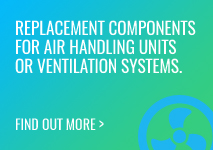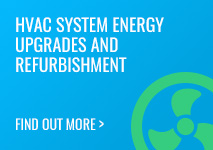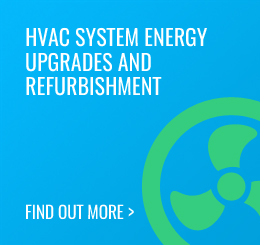AHS Specialist Services offer a variety of tailored energy efficient ventilation solutions from large industrial operation to small commercial companies, developed for individual facility needs, which deliver smooth, uninterrupted operations, reduce operational costs, prevent unexpected downtime and increase efficiency.

New AHU’s have to be designed to meet stringent regulations, the2016 Building Regulations Part L2. These list among other things a limit on the specific fan power (SFP) of each component in the AHU. As well as making the new AHU relatively expensive, it also has to be larger to limit the air pressure through each component. Where possible, existing AHU’s can be refurbished and upgraded to make them considerably more economical to run, and at the same time reduce
maintenance costs.
The biggest savings can be achieved by replacing forward curved double inlet centrifugal fans with single inlet backward curved ‘plug’ fans. These will usually have a smaller motor for the same duty requirement, and with inverter fan speed control there is the possibility of demand led control of the ventilation, or accurate commissioning with the minimum power requirement. Night setback and air quality monitoring are possible with inverter installation providing major opportunities for energy saving. AHS Specialist Services can provide a spreadsheet illustration of the energy saving with the introduction of ‘plug’ fans into AHU’s once we have carried out a survey, please contact us if you need more information on this.

Whether refurbishing old equipment or replacing with new, AHS Specialist Services will ensure the maximum reduction in energy use. The new generation of air handling unit components provide considerable savings in carbon emissions and running costs. These can be incorporated into existing equipment as part of the refurbishment process. AHS Specialist Services have specialist knowledge in all aspects of ventilation, and can advise on the benefits of either refurbishment or replacement of ventilation plant.
Initial Technical Evaluation
AHS Special Services can provide the information you need to make an informed decision.
The reports include:
-
Comparison of refurbishment and replacement of AHU’s and other equipment to include capital cost, carbon, energy saving and running costs.
-
Comparison of running cost of existing forward curved fans and the alternative EC fans or backward curved centrifugal direct drive ‘plug’ fans. These have the advantage of minimal or no maintenance, accurate commissioning, and precise control. EC fans have the advantage of low voltage control, while plug fans have inverter speed controllers.
-
Energy surveys and reports on complete system or building, including leisure centres, retail stores, cinema’s, office blocks, universities, schools and colleges, manufacturing buildings.
-
High specification site reports such as hospital surgical and ward standards, pharmaceutical and clean room applications.
The case for refurbishment
-
Cost – there is a major saving in capital outlay, along with significant savings in future running cost due the much more efficient components installed.
-
Time – reduced down time compared with complete replacement.
-
Energy saving – reduced electrical consumption with lower carbon emissions.
-
Future proofing - incorporate the latest innovations.
-
Lifespan – extended by 10 to 15 years.
-
Installation – no need for craneage or major plant movements.
-
Plant space is retained, whereas new equipment is invariably larger.
Refurbishment Issues
AHU Cases
AHU cases are subject to corrosion over a long period of time, along with poor maintenance. Water damage at the intake, and leaking coils and water carryover from cooling coils often cause damage to the case. Faulty access panel fasteners can result in the panel being levered off or not properly refitted. The insulation in single skinned air handling units can be refitted or replaced. A thorough refurbishment can resolve these issues permanently.
Air Intake
High velocity louvred air intakes in an exposed location will invariably allow rainwater to enter. These can be replaced with cowls if necessary. Intake dampers are often corroded and seized, these can be replaced and new motors fitted.
Mixing Boxes
Two or three way mixing boxes are very economical to run if properly controlled. The dampers need to work efficiently, with the motors accurately controlled. This allows 100% recirculation overnight, and the correct amount of fresh air during building occupancy. Refurbishment may include damper repair or replacement, plus new actuators.
Filters
Filters near the intake can get wet and collapse, ultimately resulting in blocked heating and cooling coils. Upgraded filter sections will require new bulkhead and channels, this will result in lower resistance to airflow, with lower power consumption.
Heating and Cooling Coils
The heating coils near the intake can get blocked and deteriorate to the point where the fins rot and flake away. Coil leaks are common over time, including frost damage leaks and general corrosion. Water carryover from cooling coils can be due to insufficient depth of trap, undersized drain outlet, blocked drain pans, excessive airflow. All these problems can be resolved. Should coils need to be replaced they can be provided with corrosion resistant fins. Large coils can be flat pack installed on site if there are space limitations.
Plate Heat Exchangers
Plate heat exchangers are often not maintained at all. The critical component is the face and bypass damper, which automatically adjusts for heat recovery or free cooling. AHS can withdraw the plate heat exchanger for cleaning, with the damper refurbished and actuator checked and replaced if necessary. The sensors and controls will also be checked to ensure correct heat recovery function.
Thermal Wheels
Thermal wheels are also not generally maintained. If the small drive motor fails, or the drive belt fails, there will be no heat recovery. Also, if the brushes are not checked and maintained regularly the efficiency will fall off considerably. The wheel faced can become blocked over time leading to a reduction in airflow. All these items can be rectified by refurbishment.
Gas Burners
The new generation of gas burners have gas condensing energy modules with efficiencies in excess of 100%. The furnace and air/flue exchanger are manufactured from stainless steel. The output automatically modulates from 100% down to 20% capacity. The complete module can replace the old unit with some case modifications to the air handling unit or rooftop packaged unit.
Centrifugal Fans
Considerable energy savings can be made by replacing forward curved double inlet centrifugal fans with backward curved single inlet direct drive ‘plug’ fans with inverter speed control, or EC fans with electronic controller. AHS Specialist Services will advise on the best option in terms of duty, cost, and efficiency. Changing the fans alone will provide energy savings of 20% on the fan running cost. Large backward curved centrifugal fans can be refurbished with new bearings and high efficiency motors, or replaced with a bank of two, three or four direct drive ‘plug’ fans.
Motors
Old motors should be replaced with the latest IE3 premium efficiency motors. Old but functioning TASC drive motors can be replaced with the high efficiency motors with inverters. This provides the potential for demand control ventilation, including night set-back, humdity and CO 2 demand ventilation. At the same time the pulleys and belts should be checked for correct selection and adjustment, as this is a potential energy wasting component if not correctly set up and adjusted.
Silencers
Silencer pod infill collapses with time, and the silencer absorbent facing becomes very dirty and difficult to clean. This increases resistance to airflow and reduces the attenuation. The silencer can be completely replaced or new pods fitted with perforated steel facings.
Controls
Both the control system and the components fitted to the air handling unit, such as sensors and valves and dampers with actuators, are a major source of energy wastage in ventilation systems. AHS Specialist Services can check all these items, replace and re-commission as necessary.
Associated Equipment:
Duct Insulation
External ductwork lagging deteriorates with time, particularly if fitted with PIB type insulation. Once it breaks down the ductwork will get wet and corrode. This can be stripped and replaced to current standards.
It is surprising how older ductwork is often not insulated at all, particularly return air ductwork. Poorly lagged or unlagged ductwork can lose 3 0 C over 20 metres, so remedial work will have an immediate benefit.
Chillers
Chillers, air conditioning units, air cooled condensers, plus air handling units and louvred air intakes are prone to getting blocked with pollen, leaves, dust and debris. They can be fitted with air intake screens, which are easy to clean and have been proved to reduce energy consumption, reduce maintenance time and prolong filter life. These screens have a rapid payback on investment.
DX Units and Rooftop Units
External AC units can be fully refurbished as detailed above, and modifications made so that a replacement refrigerant drop-in can be provided to replace R22. These include R417A and R422D.
Variable Pitch Axial Fans
While these can be efficient, the problem is often that the pneumatic actuators no longer function to operate the inlet guide vanes, so control is lost. AHS can replace these fans with super efficient EC fans, or plug fans, in banks if necessary.
Further Energy Saving Options:
OptEvent Air Handling Units
The AHS OptEvent range of air handling units sets new standards for energy efficiency.
It incorporates a packaged heat recovery system for both summer and winter, with precise temperature control. There is no cross contamination of supply air and extract air making them suitable for hospitals, healthcare, laboratories etc. The units contain an adiabatic cooler to pre-cool the extract air and maximise the cooling effect at the supply side.
Contact us for full details of OptEvent air handling units.
Note
New AHU’s have to be designed to meet stringent regulations, the2016 Building Regulations Part L2. These list among other things a limit on the specific fan power (SFP) of each component in the AHU. As well as making the new AHU relatively expensive, it also has to be larger to limit the air pressure through each component. This does not apply to the refurbishment of existing AHU’s, which when upgraded will be considerably more economical to run, and at the same time reducing maintenance costs.











